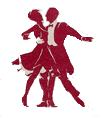 |
ROUND DANCING — CHOREOGRAPHED BALLROOMEDUCATIONAL ARTICLESMAJOR SECTIONS: Figures | Articles | Links | Alph. Index | Search | Home |
|
|
One Good Turn Deserves Anotherby Roy & Phyllis Stier April, 1988 We usually think of turns to the right or left as inconsequential figures that are necessary to fill in between more meaningful ones. As a result, we spend little time in perfecting them and even less attention to the problems they can cause. Usually the technique applied by the man is to get around the lady and face reverse line of dance; in fact this is how turns have been taught in the past, albeit not couched in these terms. Let's have a look at what they should entail, with the hope that it will smooth out some of the awkward movements that leave the dancers unprepared to do the figure to follow properly. For our purpose the turns will be confined to three steps. The waltz and quickstep turns are similar, except in timing, since they close on step 3 (can be used in tango but not in Viennese).Reverse Turn: Step 1 for the man is left foot forward toward diagonal center after shaping to the left going from heel to toe. Step 2 is to the side on the toe because by now the man has turned 1/4 left-face and both feet are pointing diagonal reverse and center. On step 3, the left closes to the right on the toe by drawing the left with floor pressure using thigh muscles to complete the turn to face reverse (additional 1/8 left-face turn). The important part of the turn is really in body rise and sway. In waltz, the rise is started after step 1 is taken and continues through steps 2 and 3, whereas most dancers rise too early and have nothing left on step 3. In quickstep, the rise is early so that the couple is up already on steps 2 and 3. None of the above can be accomplished very well without a fairly strong left sway, which develops on step 2 and continues through 3 (sway = stretching the opposite side). The one ingredient that is usually missing is the direction of movement — step 1 and 2 are on a line toward diagonal center without the slightest thought of dancing around the lady. The lady's part is nearly opposite, but on step 2 she points her foot down line of dance, while her body still faces diagonal wall. As she closes on step 3, her body will catch up with her feet. Footwork for her is toe/heel, toe, toe. She will sway right, of course, on 2 and 3 and maintain it until the first step of the next figure. In fox trot, the Reverse Turn requires a different technique for the man, as he allows the lady to do her heel turn. At the end of step 2, he will do a little extra swiveling action (called the Eggleton swivel) to face nearly reverse before stepping back on his left to face reverse. Although the footwork and sway are the same as in waltz, there is an early rise at the end of step 1 which is retained through steps 2 and 3. The lady's heel turn on 2 is accomplished by dragging the left heel back with floor pressure while completing the 3/8 left-face turn (strong right sway). Because of this technique, she will have only a small body rise on 1 and will continue to rise on 2, reaching full height on 3 while keeping her fight sway. Natural Turn: Just a mirror image of waltz and quickstep technique. The alignment of steps 1 and 2 for the man are most important because of the closed position being a little to the left of the partner. We should feel the knees almost brushing together. In fox trot, we usually start facing line of dance (after a Three Step, for instance) and this would require a 3/8 right-face turn for the man as a combination of starting to turn on 1 and completing on 2. Likewise the lady would have to get a 1/2 right-face turn with her step 1 and heel turn.
This column comes from a series published in Cue Sheet Magazine between 1987 and 1992, and is reprinted with permission. The full series is collected in an 86-pg booklet, available for $30.00 plus postage. E-mail Fran Kropf at cutecuer@cox.net. This article was published in the Dixie Round Dance Council (DRDC) Newsletter, April 2009.
|
 |
|
|
Page last revised